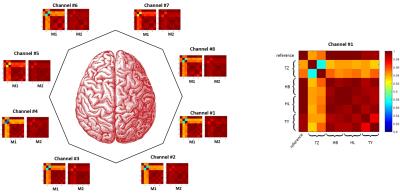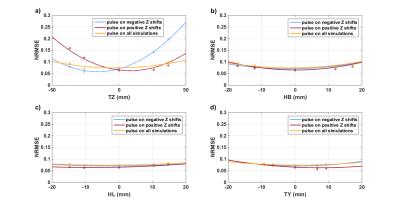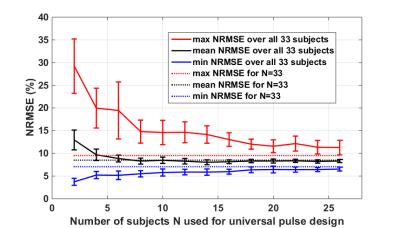1331
B1+ maps intersubject variability study for universal pulses applications in parallel transmission MRIMorgane Le Garrec1, Vincent Gras1, Michel Luong2, and Nicolas Boulant1
1DRF/I2BM/NeuroSpin, CEA, Gif sur Yvette, France, 2DRF/Irfu/SACM, CEA, Gif sur Yvette, France
Synopsis
Despite its power to mitigate B1+-inhomogeneity, subject-specific tailored parallel transmission (pTx) suffers from a cumbersome workflow involving measurement of field maps as well as online pulse design. Recently however, it was shown that RF inhomogeneity-mitigating (universal) pulses could be found offline to work robustly over a given B1+ maps-database, thus potentially sparing the user the time-consuming calibration. To gain further performance with improved database matching for universal pulses, in this work we investigate with electromagnetic simulations the intersubject B1+ map variability by systematically varying position (in Z and Y), head length and head breadth of a reference head model.
Purpose
Parallel transmission (pTx) so far has suffered from a time-consuming workflow necessitating the measurement of field maps and online pulse design. Universal pulses were recently proposed to spare the pTx user this cumbersome procedure1. Assuming a certain reproducibility of B1+ maps across subjects, the approach consists of blindly applying pulses that were designed, offline, to work robustly over a database made of several B1+/DB0 maps. The performance of these pulses was demonstrated numerically and experimentally at 7T in head imaging1. In this work we investigate numerically the reproducibility of these maps to propose database matching strategies and minimum size of database to achieve sufficient robustness.Methods
The coil under study was the 8 Tx-Rx Rapid biomedical coil (Rapid biomedical, Rimpar, Germany). Our home-made female 9-tissues surface-based head model underwent translations in Z (TZ), translations in Y (TY), deformations in head length (HL) and head breadth (HB) that were considered significant given the adult Caucasian statistics2 (up to $$$\sqrt{6}$$$ standard deviations). A total of 33 electromagnetic (EM) simulations was executed by varying these parameters one by one or simultaneously in the HFSS (Ansys, Canonsburg, PA, USA) solver. The correlations between the returned field maps were then calculated over the intersection of their brain masks (the region used to design the RF pulses) in the laboratory frame (method #1) or in the “brain frame”, after undoing the translations in TZ and TY (method #2) (Fig.1). Universal pulses were designed for one small tip angle kT-points excitation3 on three different databases consisting of: D1 (subjects #1-33), D2 (subjects #1-20 corresponding to 0≤TZ≤+36 mm) and D3 (subjects #14-33 corresponding to –36 mm ≤ TZ ≤ 0). Each pulse design consisted of minimizing the worst flip angle normalized root mean square error (FA-NRMSE) across subjects in the corresponding databases1, under explicit constraints4. For more realistic calculations, $$$\Delta B_0$$$ maps were synthetized for each head configuration5. Once a pulse was designed, individual FA-NRMSEs were computed for each of the 33 subjects using a Bloch simulation, thus allowing to determine a potential gain in partitioning the full database according to intervals in Z. Finally, to analyze the impact of the size of the database on the robustness of the NRMSE, the same kT-points universal pulse was designed on databases made of N = 2 and up to 26 subjects, taken randomly out of the 33 subjects. For each N, the procedure was repeated 20 times to select randomly 20 different subsets out of the possible combinations.Results
Figure 2 reports the channel-by-channel B1+ correlations between the reference model and the models obtained by varying TZ, TY, HL or HB. Method #2 reveals that the maps are highly similar when the brain maps are realigned, indicating a relative “attachment” of the B1+ maps to the head. Method #1 on the other hand reveals that the most sensitive transformation otherwise is TZ. Figure 3 shows the FA-NRMSE results across the 33 subjects, for the universal kT-points pulses and for the different partitioning strategies. In agreement with the correlations, Z is found in this case to be the most sensitive parameter and consequently, segmenting the database according to the Z position of the head can improve the universal pulses NRMSEs. Figure 4 finally shows that the FA-NRMSEs across the 33 subjects roughly converges when the number of subjects included in the universal pulse design exceeds 20 subjects.Discussion and conclusion
This work presents a B1+ maps intersubject variability study to propose database matching strategies for universal pulses. In the frame attached to the brains, the B1+ maps are highly similar and provide additional motivation for finding non selective kT-point pulses able to produce fairly homogeneous FA profiles disregarding possible variations in the position or the size of the head. By partitioning the full database (33 head models) into Z intervals for database matching, the universal pulse design performance indeed could be noticeably improved. The minimum size of the database to obtain the NRMSE robustness over 33 different models in this work was estimated at around 20. While this number certainly increases the computing demand compared to subject-based tailored solutions, it remains reasonable considering that the calculation is performed offline. Finally, the variations enforced on the average head model to perform this study explored large, somewhat unlikely occurring values from a statistical standpoint2. As a result, the worst case NRMSEs in Fig.4 correspond most likely to rare scenarios, so that the size of the database can possibly be decreased further at around N = 12.Acknowledgements
The research leading to these results has received funding from the European Research Council under the European Union’s Seventh Framework Program (FP7/2013-2018), ERC Grant Agreement n. 309674.References
[1] Gras V et al. MRM doi: 10.1002/mrm.26148. [2] Ball R et al. Applied ergonomics 2010 ;41 :832-839. [3] Cloos M et al. MRM 2012;67 :72-80. [4] Hoyos-Idrobo et al. IEEE Trans Med Imag 2014 ;33 :739-748. [5] Salomir R et al. Concepts Magn Reson Part B 2003;19B:26-34.Figures

Figure 1. Methods #1 and #2 to
calculate the correlation between B1+ maps. Method #1 takes the
intersection over the respective brain masks in the laboratory frame while
Method #2 takes their intersection after undoing the position shifts.

Figure 2. Correlations between the B1+ maps for
each channel and for methods #1 (M1) and #2 (M2). The maps are highly similar
when compared in the frames attached to the head (M2). Method #1 reveals
smaller correlations when absolute positions are taken into account, especially
in the case of large Z translations (± 36 mm). Labels for the different individual
translations are shown on the right.

Figure 3. NRMSEs obtained for the 33 subjects after universal
pulse design performed on D1, D2 and D3. The NRMSEs are plotted with respect to
their position in the parameter space (TZ, HB, HL and TY). a) Better NRMSEs are
obtained for the individuals comprised between 0 and + (or -) TZ=36 mm when
partitioning the universal pulse design database accordingly. The other
subplots reveal less NRMSE variability with the other parameter variations b)
HL, c) HB and d) TY. Solid lines are second order polynomial fits to guide the
eye.

Figure 4. Worst (red), mean (black) and best (blue) FA-NRMSEs
obtained over the 33 subjects versus size N of the database employed for
universal pulse design. For each size N, the universal pulse design was
repeated 20 times each time selecting a different random sub-ensemble of size N
out of the 33 subjects. The average value was then plotted against N. The error
bars display the FA-NRMSE variability across the 20 pulse designs. The dashed
lines display the worst, mean and best FA-NRMSEs reached with the 33-subject
pulse design. Convergence occurs in this case at around 20 subjects.